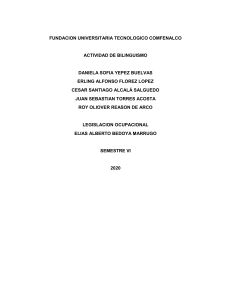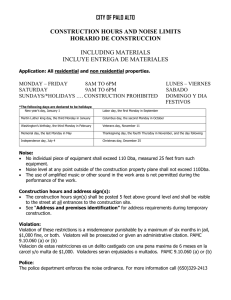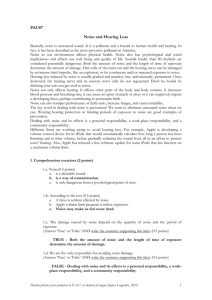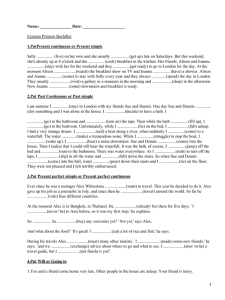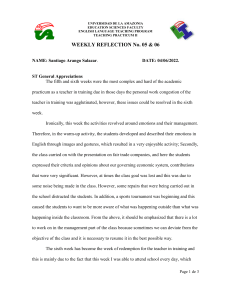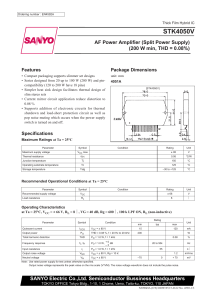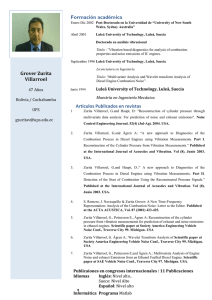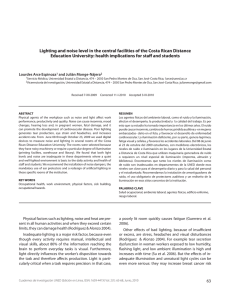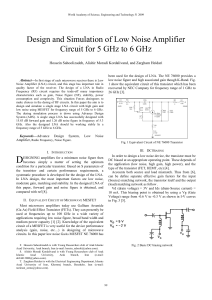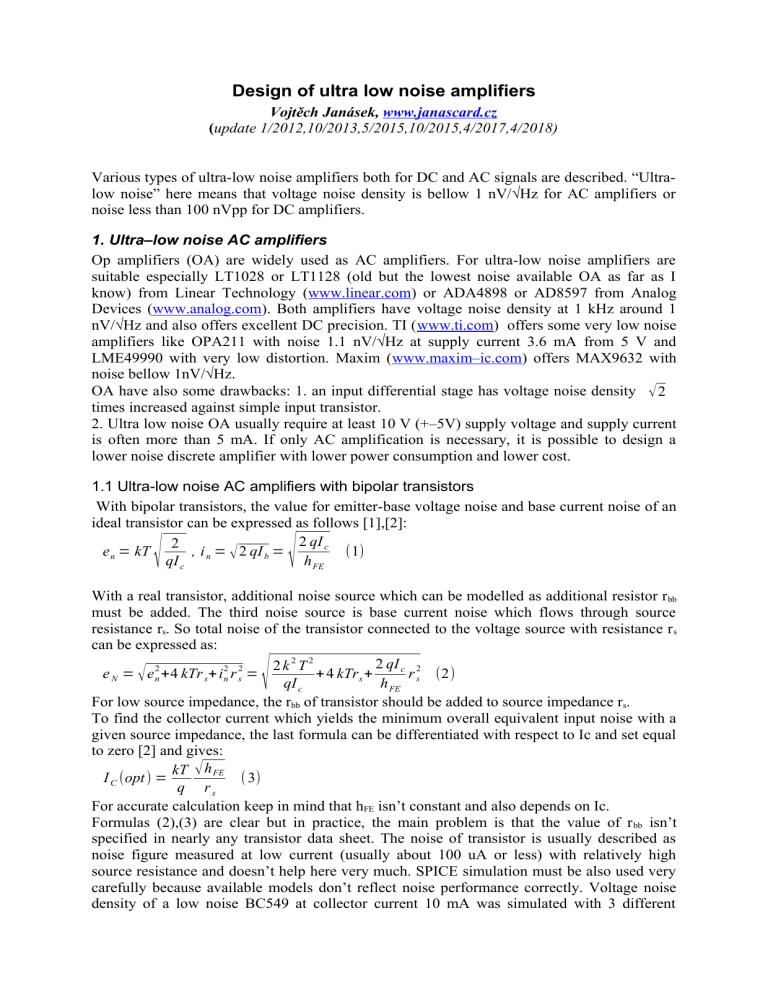
Design of ultra low noise amplifiers Vojtěch Janásek, www.janascard.cz (update 1/2012,10/2013,5/2015,10/2015,4/2017,4/2018) Various types of ultra-low noise amplifiers both for DC and AC signals are described. “Ultralow noise” here means that voltage noise density is bellow 1 nV/√Hz for AC amplifiers or noise less than 100 nVpp for DC amplifiers. 1. Ultra–low noise AC amplifiers Op amplifiers (OA) are widely used as AC amplifiers. For ultra-low noise amplifiers are suitable especially LT1028 or LT1128 (old but the lowest noise available OA as far as I know) from Linear Technology (www.linear.com) or ADA4898 or AD8597 from Analog Devices (www.analog.com). Both amplifiers have voltage noise density at 1 kHz around 1 nV/√Hz and also offers excellent DC precision. TI (www.ti.com) offers some very low noise amplifiers like OPA211 with noise 1.1 nV/√Hz at supply current 3.6 mA from 5 V and LME49990 with very low distortion. Maxim (www.maxim–ic.com) offers MAX9632 with noise bellow 1nV/√Hz. OA have also some drawbacks: 1. an input differential stage has voltage noise density √ 2 times increased against simple input transistor. 2. Ultra low noise OA usually require at least 10 V (+–5V) supply voltage and supply current is often more than 5 mA. If only AC amplification is necessary, it is possible to design a lower noise discrete amplifier with lower power consumption and lower cost. 1.1 Ultra-low noise AC amplifiers with bipolar transistors With bipolar transistors, the value for emitter-base voltage noise and base current noise of an ideal transistor can be expressed as follows [1],[2]: 2 qI c 2 e n = kT , i n = √ 2 qI b = (1) qI c h FE √ √ With a real transistor, additional noise source which can be modelled as additional resistor r bb must be added. The third noise source is base current noise which flows through source resistance rs. So total noise of the transistor connected to the voltage source with resistance r s can be expressed as: 2 qI c 2 2k2T2 e N = √ e 2n +4 kTr s+ i 2n r 2s = + 4 kTr s + r (2) qI c h FE s For low source impedance, the rbb of transistor should be added to source impedance rs. To find the collector current which yields the minimum overall equivalent input noise with a given source impedance, the last formula can be differentiated with respect to Ic and set equal to zero [2] and gives: kT √ h FE I C (opt) = ( 3) q rs For accurate calculation keep in mind that hFE isn’t constant and also depends on Ic. Formulas (2),(3) are clear but in practice, the main problem is that the value of r bb isn’t specified in nearly any transistor data sheet. The noise of transistor is usually described as noise figure measured at low current (usually about 100 uA or less) with relatively high source resistance and doesn’t help here very much. SPICE simulation must be also used very carefully because available models don’t reflect noise performance correctly. Voltage noise density of a low noise BC549 at collector current 10 mA was simulated with 3 different √ models – OrCAD’s built-in model, a model from Philips and model from Fairchild. Three totally different results were obtained: 0.12 nV/√Hz, 0.19 nV/√Hz and 1.3 nV/√Hz and corresponding rbb is 0 , 1 and 100 . The last value is the closest to reality. That measurement also shows that so-called “low noise” transistors are not suitable for really low noise applications at higher collector current due their high rbb value. It can be expected that transistors with higher Icmax have also lower rbb, so several transistors with higher Icmax were measured. Commonly available transistors like 2N3904, 2N2222, BC337, BC817,BCP68 were tested. All that transistors had lower noise at Ic=1.3 mA than BC549. The lowest noise was obtained with the BC337 (r bb= 30 ), SMD version BC817–40 is slightly worse. Update 5/2015 – nearly perfect low noise transistor seems to be 2SC3324 (PNP version is 2SA1312) with specified noise at higher Ic. R bb is only 20 according to datasheet and β is up 700 so input noise current is also very low. Unfortunately, measurement of several samples 2SC3324 shows rbb 35 – worse than BC817–40. Update 4/2017 – [6] says that the lowest noise transistors are ZTX851/ZTX951 with r bb 1.7/1.2 , another choice is ZTX(FMMT)618/718 with rbb 9.3/7.3 with higher β, and many others. [6] is an excellent source of valuable information about analogue design – I highly recommend it. V1 5Vdc C2 220u R3 1.3k T2 R2 1.5k BC559C C3 0 INPUT C1 10u OUT R4 T1 56k R1 22u BC337 16k 0 R5 510 R6 4.7 0 Fig.1. An ultra-low noise AC amplifier. The Fig. 1. shows a practical example – an ultra-low noise amplifier with gain 100 based on BC337 derived from [2]. Although very simple, the amplifier has input noise below 0.7 nV/√Hz – lower than any monolithic OA and requires only 3 mA from 5 V supply. Gain is set by the ratio of R5, R6, a noise of R6 is added to input noise so low value 4.7R is used. Small signal bandwidth exceeds 1 MHz. This simple approach has also some drawbacks, the main is that output voltage swing is limited to only several hundred mV. An open loop gain of the amplifier is only 60 dB, so gain accuracy, distortion performance and output impedance is worse compared to OA. Flexibility is a big advantage of the circuit – increasing resistors R1=160k, R2=27k, R3=22k, R4=560k, R5=2.4k, R6=22 reduces supply current to 200 uA and voltage noise density is still only 1.7 nV/√Hz, it is about 10 times lower than an OA with the same current consumption. Small signal bandwidth exceeds 100 kHz, it is also very good value for such low power circuit. An improved version of the ultra-low noise amplifier is shown in Fig.2. PNP transistor was replaced with OA. Q1’s collector voltage is set by resistor divider R7, R6, bias point is controlled via DC feedback path R2. The noise contribution of the U1 can be neglected if its noise density is lower than en*Au/3 where en is voltage noise density of input transistor, Au is gain of the input stage, Au = 40 * Ic * R3. With values shown in Fig.2, an amplifier with noise density bellow 20 nV/√Hz should be used. Gain is precisely set by divider R2, R1||R9, gain up 10000 is possible due high open loop gain of the U1. Distortion and output impedance is also greatly reduced over the previous circuit. Low frequency corner is given by R1C4. DC bias of C4 is bellow 100 mV so a low voltage low ESR type can be used. Fig.2. An improved version of ultra-low noise amplifier. Both circuits have voltage noise density around 0.7 nV/√Hz, if lower noise density is required, input transistors can be simply paralleled. If N transistors are used, noise is √N reduced and a result can be modelled as one transistor with r bb’ = rbb/N and Ic’= N * Ic. This approach has also some drawbacks – base current noise is √N times increased and transistors should be matched. Matched monolithic pairs are available from several vendors, for instance, LM394 from National Semiconductors (www.national.com) or MAT–01, MAT–02, MAT–03 from Analog Devices. The matched pairs have also very low and fully specified noise at higher collector current. If more transistors are necessary, matched quad THAT300 from THAT corporation (www.thatcorp.com) is available. The main disadvantage of the matched transistors is a high price. Transistors needn’t be matched with high accuracy, 20% difference in collector current is acceptable, so raw selection (or no selection at all) of BC337(BC817– 40) can be done. If no selection is used, equalization emitter resistors 100 with blocking capacitor 470 uF in every emitter reduce differences between transistors – Fig .3. C B BC337 BC337 470u 470u 100 100 E Fig. 3. Paralleling with balancing emitter resistors. 1.2 Ultra-low noise AC amplifiers with unipolar transistors Amplifiers with bipolar transistor offer very low noise but have also some drawbacks – low input impedance and high input current noise, so they are suitable especially for signal sources with low output impedance, typically below 1 kOhm. If high input impedance or very low input noise current is necessary, an input stage with unipolar transistors is a better choice. OAs with FET inputs exists, but their noise is significantly worse than with bipolar ones – en is usually higher than 4 nV/√Hz. An example is JFET OPA827 from TI, LT1792 from Linear Technology or CMOS AD8655, AD8656 from Analog Dev, MAX4475 from Maxim. Unipolar transistors in ultra low noise applications have two disadvantages: 1/f noise corner is relatively high – usually more than 1 kHz (bipolar transistors have 1/f noise corner some Hz or tens Hz) and voltage noise density is relatively high – usually some nV/√Hz or more. A noise of the unipolar transistor can be modelled as a noise of the resistor with value 1/Yfs, so transistors with high transfer admittance and usually high Idss are good candidates for low noise applications. Fortunately, there are a few types with very low noise. That is an ultra low noise JFET 2SK170 and 2SK369 from Toshiba (now obsolete) or equivalent LSK170 from Linear Systems (www.linearsystems.com)[5] with voltage noise density bellow 1 nV/√Hz. BF862 from Philips is another excellent choice but its noise is specified at 100 kHz. InterFET has very low noise IF9030 and IF3601 with noise density 0.5 and 0.3 nV/√Hz respectively and low 1/f corner, but they have large capacitances and they are quite expensive, so using more BF862 in parallel may be a better option. Fig. 4. shows an ultra-low noise amplifier with two JFETs 2SK170 with gain 100 and voltage noise density bellow 0.7nV/√Hz. As with bipolar transistor, T3 can be replaced with OA, but care must be taken because voltage gain of the input stage Au = Yfs * R2 is usually lower than with a bipolar transistor at the same Ic, so a low noise OA must be used. If lower noise than 1 nV/√Hz is necessary, JFETs can be paralleled as shown on Fig.4. If only two transistors are necessary, matched pair LSK389 from Linear Systems is a good choice. V1 C2 220u 5Vdc INPUT BC559C C5 T2 C1 T1 10u R1 J2SK170 J2SK170 10M 0 R5 OUT C3 470u C4 R4 150 150 0 1.3k T3 R2 510 0 R3 22u R7 560 470u R6 4.7 0 0 Fig. 4. An ultra-low noise amplifier with FET. Matching of single transistors is more difficult than with bipolar due to wider spread of Idss between JFETs, so it is usually simpler to set DC bias point for every transistor separately and use AC feedback only as shown in Fig 4. A drawback of no DC feedback is worse bias point stability and accuracy, so it can be necessary to replace R2 with trimmer 1k and set T3 Uce to 2.5V–3.0 V. The big advantage against bipolar transistors is that there is nearly no input current noise, so it is simple to connect in parallel as many transistors as necessary. The limit is only power consumption and increased input and feedback capacitance. If low input capacitance and high bandwidth is important, BF862 is the best choice. 1.3 Test of two highly parallel amplifiers (Update 10/2015) For verification of the mentioned ideas two versions of the amplifier – bipolar and unipolar – with many input transistor in parallel were designed, built and tested. The first version uses 8 bipolar BC817–40 in parallel with total Ic = 5 mA with no previous matching and no equalizing emitter resistors. Topology was based in the Fig.2. only the collector resistor was replaced by another BC817 wired as cascode for lowering feedback capacitance and increasing bandwidth. A gain of the amplifier was set to 1000. SPICE simulation of amplifier shows en = 0.36 nV/√Hz, total base current is 10.4 uA and corresponding noise current in = 1.8pA/√Hz, so for source resistance lower than 200 noise of the resistor dominates over the current noise. The Fig. 7 shows a noise spectrum on the output of the amplifier, the vertical axis is noise density in dBV/√Hz, input referred noise is 1000x lower. For more about noise measurement, see Appendix A. Graph shows flat noise spectrum with 1/f corner somewhere at 300 Hz. Fig. 7. A noise of the amplifier with 8 BC817 in parallel. The second version of an amplifier was populated by 9 BF862 and also uses cascode in a drain of transistors and OA on the output. BF862s are connected simply in parallel with no matching and no current balancing, total Id current is 18 mA – 2 mA per transistor. Theoretical noise density of amplifier en = 1/√9 = 0.33 nV/√Hz, a measured value is again 0.36 nV/√Hz at 10 kHz, but 1/f corner is significantly higher at 2 kHz. Fig. 8. A noise of the amplifier with 9 BF862 in parallel. These measurements clearly demonstrate pros and cons of a bipolar amplifier – lower 1/f corner, lower power but higher input noise current versus a unipolar amplifier – high input impedance and negligible input noise current but higher 1/f corner and higher power consumption. Tests also show that exact matching of transistors isn't usually necessary and mismatching has minimum impact on noise performance. Another example of the amplifier based on many bipolar transistors in parallel can be found in [6]. 1.4. Transformer-based amplifiers (Update 4/2018) Earlier mentioned amplifiers are suitable for signal sources with impedance some tens of Ohms or more. If it is necessary to amplify ac signals from sources with significantly lower impedance, transformers can be used. A transformer with turn ratio 1:n increases signal n times and source impedance is increased n 2, so it is theoretically possible to match any source impedance to any amplifier. In reality there some limitations, especially wire resistances of the transformer. There are several manufacturers of the signal transformers, for instance, Jensen Transformer which produces high-quality audio transformers (their web is also a good source of valuable information about using signal transformers). These transformers can be used also in other fields with a frequency range from a few Hz to 100 kHz. Another example of the signal transformer is Model 1900 from Signal Recovery with turn ratio 1:100 and 1:1000 and very low winding resistance of 0.04 and equivalent input noise 30 pV/√Hz. Its drawback is a narrow frequency range which is limited to only several kHz. Unfortunately, this transformer seems to be obsolete now. Stanford Research Systems offers transformer based preamplifier SR554 which consists from a transformer 1:100 and an output amplifier with gain 5. This amplifier achieves noise 0.1 nV/√Hz (noise equivalent of a resistor 0.6 ). It is also possible to make such a transformer itself or use the service of some transformer manufacturer. The main advantage of the custom design is its possibility to fit exact specific needs – source resistance and required operating frequency range. When a modern nanocrystalline toroidal core with µr up 100000 is used, CMRR > 120 dB at 50 Hz can be achieved even without Faraday shielding between windings. High core permeability also brings very low leakage inductance and corresponding sensitivity to EMI but a magnetic shielding preferably from mu-metal is still highly recommended. For performance verification, a sample of such transformer was realized and tested. The nanocrystalline toroid core was used with two same primary windings and step-up ratio 1:15 in a series configuration and 1:30 in a parallel configuration. The resulting equivalent DC resistance is 20 m in 1:30 configuration and 80 m in 1:15 configuration. This transformer together with a FET amplifier with 4 LSK170/BF862 in parallel with input noise 0.5 nV/√Hz gives total input noise 25 pV/√Hz (equivalent noise resistance 37 m) in 1:30 configuration and 50 pV/√Hz (equivalent noise resistance 150 m) in 1:15 configuration. The frequency bandwidth in 1:15 configuration and source resistance 0.5 is from 10 Hz up to 1 MHz. The measured CMRR > 130 dB at 50 Hz. This example shows that such transformer based amplifier is a perfect choice for amplification signals from sources with resistance significantly below 1 . Splitting primary windings into two sections adds flexibility for optimum matching to source resistance from tens mOhms to several Ohms. The galvanic isolation is a very pleasant benefit which eliminates ground loops – a common problem in low-level measurement when more instruments are used. 2. Ultra–low noise DC amplifiers For accurate amplification of small DC signals, amplifiers with low offset, low offset drift and low noise are necessary. The best choice between bipolar OA is the same OAs as for AC amplifiers. If even better parameters are necessary, chopper or autozero amplifiers must be used. There is a lot of monolithic choppers or autozero amplifiers with excellent offset and offset drift performance but noise performance is much worse than with mentioned bipolar OA although the main noise source – 1/f noise is removed. Typical values are more than 20 nV/√Hz. Fortunately, some new amplifiers with improved performance appear, actually it is ADA4528 with en 5.6 nV/√Hz. Better results can be obtained with discrete chopper amplifier described above. This chopper amplifier is based on a 40 nVpp Chopped FET Amplifier [3],[4] but it is significantly improved. It has lower noise, power consumption and component count. The main difference is a very low noise AC amplifier composed by T1 and T2, see Fig.5. The excellent noise performance is given by T1 – 2SK170 operating with Id current about 2 mA and with noise density below 1nV/√Hz. A total gain of the AC amplifier is given by resistors R2 and R5 and is approximately 1000 for R5 = 1 k, approx. 3000 for R5=4.7 k. The noise and offset performance of the chopped amplifier is also affected by the input modulator. MAX4693 (U1A) is used here because it has very low Ron 20 and very low charge injection 2 pC. U1B acts as an output demodulator and a demodulated signal is than integrated by U2. Total DC gain (1000) is set by R8, R9 ratio. A noise of the R9 directly affect total noise so the very low value 1 is used here. CD4060 is used as a clock source with a quartz 32.768 kHz which produces accurate and stable frequency 1024 Hz. This frequency is harmonically unrelated to 50 Hz. It will be better to use different frequency for 60 Hz suppression. 5V R2 U1A INPUT 12 11 I0 O I1 C 1k 2SK170 T1 C1 R4 C4 1k3 T2 220u BC559C 13 3 16 C5 1u R1 C2 1n C3 1M MAX4693 R5 R3 220u 0 150 C6 1 100n U1B 0 R6 I0 I1 O C R7 4 OUT + LT1097 0 0 -5V 1u M22 MAX4693 M1 1k U2 15 R8 0 1k R9 1 C7 0 0 22p C8 22p U3 R11 220k Q1 32.768 kHz R10 10M 5V 9 10 11 12 0 16 OSC OSC CLK RST VCC 0 Q4 Q5 Q6 Q7 Q8 Q9 Q10 Q12 Q13 Q14 7 5 4 6 14 13 15 1 2 3 1024 Hz 4060 Figure 5. A chopper amplifier with noise 8 nVpp. Total bandwidth is given by the gain of the AC amplifier and time constant of the integrator (R7,C6). With values in Fig.1 and AC gain 1000 (R5=1k) the bandwidth is approx. 0.2 Hz and is the same as original [3],[4]. Increasing the value of R5 to 4k7 gives wider bandwidth 0.6 Hz and also lower offset voltage. If wider or narrowed bandwidth is required, C6 can be changed accordingly. Fig. 6 shows measured noise on the output of the amplifier with AC gain 1000 (R5=1k) during 60 s time window. A DAQ card AD14PCI with additional amplifier and software Adcontrol was used. Total noise referred to input is 8 nVpp or 1.4 nVef, it is approx. 5 times improvement against original [3],[4]. The sampling period of the DSP integrating AD converter is 40 ms, so measured bandwidth is about 10 Hz, but noise bandwidth is limited by the chopper amplifier to 1.57 x 0.2 Hz = 0.3 Hz and voltage noise density en is 2.6 nV/√Hz. As with every chopped amplifier, there is no 1/f noise component so total noise for different bandwidth can be simply expressed as U n = e n √ f s (4) where fs is noise bandwidth – for 1. order low pass fs = 1.57 * f–3dB en – voltage noise density – 2.6 nV/√Hz Figure 6. Output noise in 60 s sample period. 3. Instrumentation amplifiers Instrumentation amplifiers are used for amplification of differential signals typically from bridge sensors like strain gauges. An offer of ultra-low noise monolithic instrumentation amplifiers isn't wide, it is only INA103 and less expensive INA163 from TI, both have en=1nV/√Hz. THAT offers similar THAT1510 with a wider bandwidth. A new AD8429 from AD has the same noise and also offers full DC specification and lower input currents at expense of higher input current noise. 4. Practical recommendations for the design of low noise amplifiers Every resistor is a noise source so it is necessary to keep all resistors in a signal path (and also signal source resistance) on the very low level otherwise low noise performance of any amplifier will be wasted. Proper supply decoupling (omitted for clarity) is necessary. A parallel combination of a large electrolytic cap 470uF with several 100nF–10uF ceramic in every supply with serial resistor 47–100 is recommended. If switching regulators are used, additional RC/LC filter is essential. A PCB with at least 2 layers and a solid ground plane is strongly advised. Electrostatic and magnetic shielding is also useful, especially in noisy environment. For DC amplifiers, the circuit must be also well shielded from air currents to eliminate the possibility of thermoelectric effects. Every connection of two different metals creates thermocouple with sensitivity 1–10 uV/K, so temperature difference only 0.01 °C generates 10–100 nV, up to 10 times more than the noise of the described chopper amplifier! 5. References [1] Dostál Jiří, Operační zesilovače, SNTL Praha 1981 [2] National Semiconductors, AN–222 – Super Matched Bipolar Transistor Pair Sets New Standards for Drift and noise, http://www.national.com/an/AN/AN–222.pdf#page=10 [3] Williams Jim, Linear Technology Application Note 93 http://www.linear.com/pc/downloadDocument.do?navId=H0,C1,C1010,D4182 [4] Williams Jim, Linear Technology Magazine March 2006 p.39, http://www.linear.com/ltmagazine/LTMag_V16N1_Mar06.pdf [5] http://www.linearsystems.com/datasheets/LSK170.pdf [6] Hill Winfield, Horowitz Paul, The Art of Electronics Third Edition, Cambridge University Press 2015, ISBN 978-0-521-80926-9 Appendix A – noise measurement Noise measurement can be done the most easily by a spectrum analyzer. But common RF analyzers are not suitable because they usually have low-frequency limit several kHz so a FFT analyzer working from low frequencies like SR760 is necessary. Such an analyzer is the best choice but it isn't a common equipment in a laboratory. Fortunately, other lower cost alternatives exist. Nearly any DAQ card or a module with sampling rate at least 50 kS/s and resolution 12 bits or more with appropriate software computing PSD can be used. If such DAQ module isn't available basic noise measurement can be done only with a simple bandpass filter and a true RMS voltmeter – see Fig. A. Bandwidth of the bandpass filter can be chosen according required bandwidth of the amplifier but I recommend to use reduced bandwidth with low corner at least at 1 kHz or higher for elimination of 1/f noise and attenuation of 50/60 Hz EMI and its harmonic from mains. Correct noise measurement can be done only assuming that the measured noise is white in the selected bandwidth. Exact noise bandwidth of such filter is usually unknown, so some calibration is necessary. The described calibration is also very useful when a spectrum analyzer or a DAQ system measuring noise density directly is used for checking the validity of measured results. Tested amplifier Band Pass filter True RMS voltmeter Fig. A. Principle is simple – the output noise of the amplifier with shorted input is measured first – value N, where N = k.en, than the noise of the amplifier with resistor connected between the input of the tested amplifier and ground is measured again – value M. Choose the resistor with resistance generating approximately 2 x higher noise density er than amplifier itself – values bet ween 50–100 ar e us ual l y OK. The output noise of the amplifier with the resistor on the input has value: 2 2 2 M =N + e r⋅k 2 So unknown gain k respecting also noise bandwidth of the filter can be computed from a formula: √ M 2−N 2 (5) e 2r and the input noise density en of the amplifier itself is N e n= k regardless of the unknown noise bandwidth of the used bandpass filter. k=
